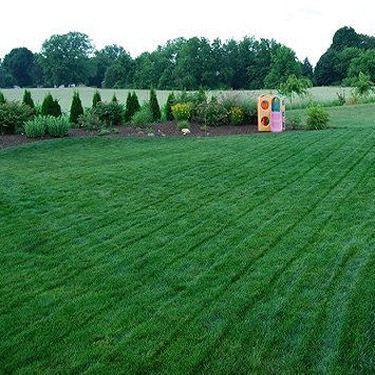Having a beautiful lawn is a lot easier if you choose the right type of grass for your situation. Even if you already have a lawn, but it needs help, you can improve it.

Northern Grasses
In roughly the northern half of the United States, cool-climate grasses are used for lawns. In this part of the country, lawns put on most of their growth in spring and fall and slow down in the hot months of summer and the cold months of winter. The most common grasses are:
Kentucky bluegrass. Grass seed mixes in the North will have a high proportion of Kentucky bluegrass. A mix that is identified for sunny areas should have mostly bluegrass, since it does best in sun.
Fine Fescues. Most fescues have finer blades than Kentucky bluegrass, and since they do well in shady areas, they are the dominant seeds found in grass mixes for shade. Red fescue and chewings or hard fescue are favorites. Tall fescue has a wider leaf blade, almost like Kentucky bluegrass, and stands up to hot summers better than Kentucky bluegrass.
Perennial ryegrass. These have a Kentucky bluegrass-like look and feel, but grow from seed much faster. Many named varieties are available and these are often combined with Kentucky bluegrass and fine fescue in grass seed mixtures.
Grass seed mixes may also contain annual rye grass. This establishes quickly and dies after one season. It is used to stabilize the area while the premium grasses become established. It is also used to cover vegetable gardens that will not be used for one season, then turned under when it is to be replanted. Avoid using annual ryegrass for a permanent lawn.
If your lawn appears to be thin--for example in a shady area--try overseeding. Just before the growth season in spring and fall, scatter grass seeds over the existing lawn and rake them down into the root zone. Keep the area watered.
Two areas of the country don't quite fall neatly into the conditions that clearly favor cool-climate grasses or warm-climate grasses. One of these is the area of the high plains, where native grasses such as buffalo grass and wheatgrass are used--particularly where there is no irrigation. The other is a transition zone that runs like a belt from the southern half of California to North and South Carolina. Both the northern and southern grasses are found here, and local conditions make the right choice critical. Garden centers should be consulted for local knowledge.
Warm-climate grasses
These are found throughout the South. Often they are wide-bladed and coarse compared to the northern grasses. They put on vigorous growth during summer and go dormant and turn brown in winter. Golf courses and some homeowners keep lawns green by overseeding with annual rye grass toward the end of the growing season. Instead of being started from grass seed, lawns of warm-climate grasses are usually started from planting sprigs, plugs, or sod.
Bermuda grass. Durable and heat-loving, Bermudagrass is the most common of the warm-climate grasses. It does not do well in shade. Hybrid bermuda grass is very soft and fine-bladed and is therefore a common choice for golf greens in southern regions.
Centipedegrass. This grass makes a good lawn in hot areas, although it is lighter green in color and subject to drought damage because of shallow roots. It does well in poor soil.
St. Augustine grass. St. Augustine does well in shade and is fast-growing, but is subject to damage from chinch bugs. It prefers slightly alkaline soils over acid soils.
Zoysiagrass. This grass establishes slowly, but when it gets going forms a dense, wirey, fine-textured lawn and is resistant to heat and drought. It tolerates shade, where it grows slowly. Zoysiagrass is relatively free of diseases and insect problems. Many improved varieties are available.
If you have deep shade, steep banks, or other problem areas, it might be worth investigating the many ground covers that can be used in place of grass lawns.